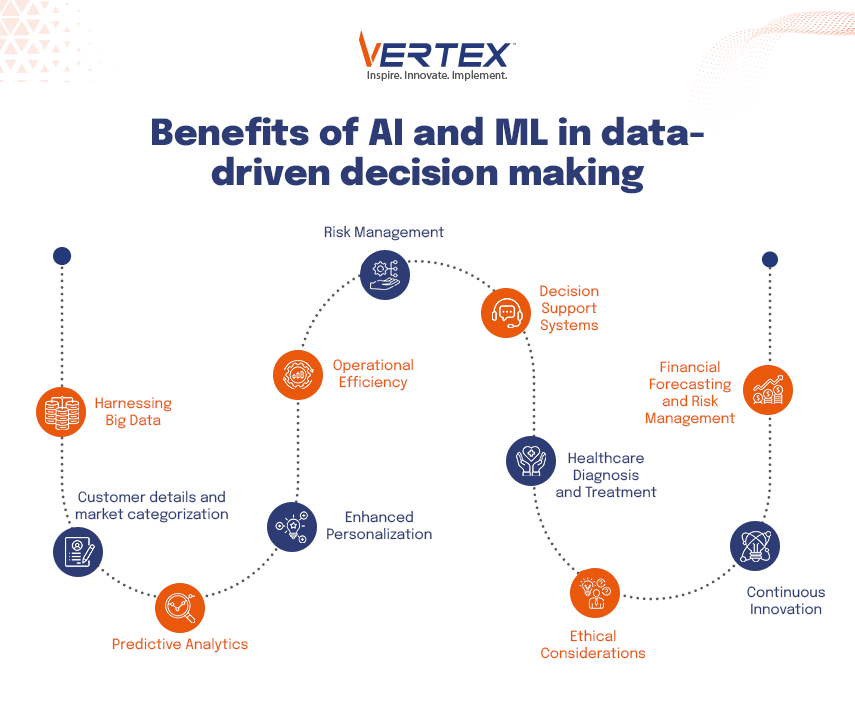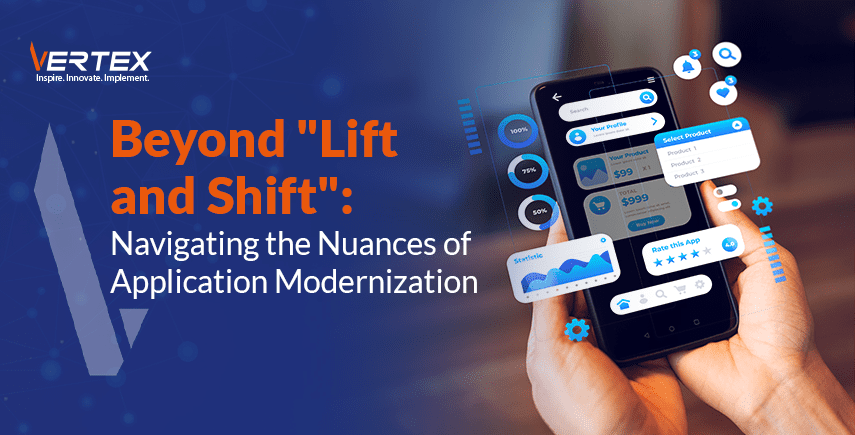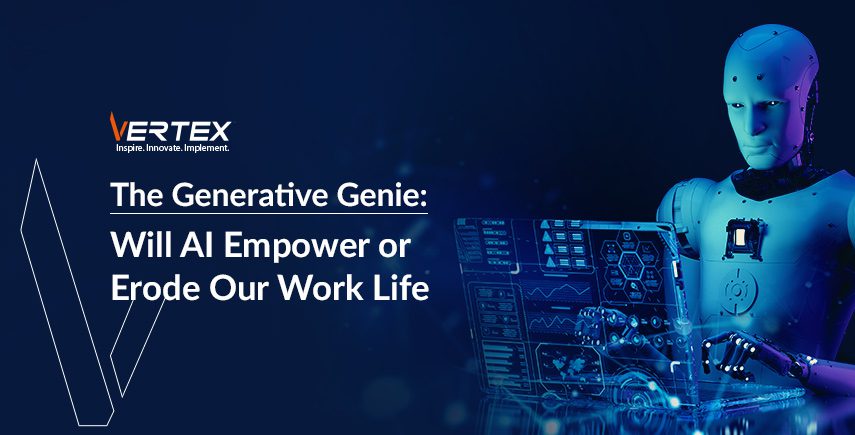
Venkatesh Balabhadra
June 03, 2024The power of AI and Machine Learning in data-driven decision making
Today, where a lot of data is produced, companies are employing artificial intelligence and machine learning to analyze the data. This makes the decision-making process in organizations more strategic and informed. Thus, in this Vertex blog post, we will discuss how artificial intelligence and machine learning influence the approaches to data analysis.
11 Benefits of AI and ML in data-driven decision making

1. Harnessing Big Data
AI and machine learning have revolutionized the analysis of big data in ways that were previously impossible. Businesses can now collect, process, and interpret both structured and unstructured data in real time. This capability allows them to gather more comprehensive information about customers, their behavior, the market, and even internal operations. Consequently, big data enables organizations to uncover new patterns and relationships that are not easily discernible using traditional methods.
2. Customer details and market categorization
Big data is processed using machine learning tools to uncover valuable information about customers, their actions, and their preferences. This allows companies to better understand their customers and develop tailored marketing communication messages and products for specific segments. Customer segmentation and targeting are effective approaches to enhancing customer satisfaction and brand loyalty, thereby increasing revenues in a competitive market.
3. Predictive analytics
The advantage of using AI and machine learning in decision-making lies in their predictive analytics capabilities. These technologies assist in forecasting future trends and outcomes by analyzing past data. Predictive analytics can forecast customers’ preferences and demand, as well as assess potential risks. This helps organizations anticipate future events, address or prevent them, optimize resource utilization, and adjust strategies accordingly.
4. Enhanced personalization
Understanding the needs and behaviors of consumers helps organizations create products, services, and advertisements that appeal to their target audience. This enhances customer satisfaction and loyalty, leading to higher revenues. Machine learning refines these recommendations through actual user interactions, making them increasingly realistic and feasible.
5. Operational efficiency
AI and machine learning assist in supply chain management, logistics, manufacturing and many other processes to be efficient, cheap and precise. Some of the uses of big data include; Predictive maintenance, whereby machines are observed and analyzed to determine the time that they are most likely to develop a fault and this is done before the fault occurs hence avoiding unnecessary faults.
6. Risk management
It enhances risk management by searching records and, in the process analyzing risks or threats as they are. Fraud detection systems use machine learning to identify potential frauds and thus reduce losses. Similarly, cybersecurity tools that are related to artificial intelligence search for threats and respond to them before they can affect customer data and confidence.
7. Decision support systems
Decision support systems supplement the abilities of leaders by offering them data that they can use. These systems include the application of large datasets for making forecasts and for the formulation of the appropriate strategies to be adopted. In financial management, the healthcare sector, and marketing, AI is used to make decisions as soon as possible with the data. The integration of data from multiple sources is useful when using AI in decision-making.
8. Healthcare diagnosis and treatment
AI and machine learning in the healthcare sector transform diagnostics, treatment, and the relationship with the patient. In the healthcare industry, physicians and other healthcare practitioners use AI algorithms to identify diseases through images and to predict how the diseases will develop. It not only helps in diagnosing diseases but also helps in planning treatment based on patient records.
9. Ethical considerations
AI has several advantages; however, its use should be controlled, and the rules of ethical behavior should be followed. Organizations should ensure that the use of AI systems is fair and accountable. This is because regulations and policies are a significant component of AI that guarantee that the use of AI is ethical and safe for society.
10. Continuous innovation
AI and ML are the two most significant enablers of sustainable innovation. Over time, the collection, analysis, recognition, and automation capabilities are also enhanced due to the use of technology. This has contributed to the development of firms and the ability to deal with new trends in the market.
11. Financial forecasting and risk management
In the financial sector, AI algorithms enhance the accuracy of financial forecasts and risk evaluation. Computational models use mathematical and probabilistic modeling of historical financial data, market trends, and macroeconomic indicators to predict investment returns and risks. It helps financial institutions manage their portfolios, risk hedging, and compliance with regulatory requirements in a better way.
Shaping the future with AI-driven strategic management
Thus, as businesses evolve, AI use will certainly remain one of the pillars of strategic management that will shape the future based on the data. So, call Vertex today and learn more about artificial intelligence and machine learning.
Let us find a better way together in business!
Recent Blogs

19 May, 2025

19 May, 2025

12 May, 2025

5 May, 2025

28 April, 2025

21 April, 2025

14 April, 2025

7 April, 2025
Recent News

2 February, 2025

14 November, 2024

4 November, 2024

1 August, 2024

6 March, 2024

28 February, 2024

12 June, 2023



